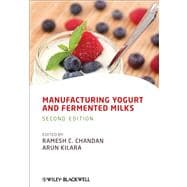Melding the hands-on experience of producing yogurt and fermented milks over four decades with the latest in scientific research in the dairy industry, editor Chandan and his associate editors have assembled experts worldwide to writeManufacturing Yogurt and Fermented Milks, 2nd Edition. This one-of-a-kind resource gives a complete description of the manufacturing stages of yogurt and fermented milks from the receipt of raw materials to the packaging of the products.
Information is conveniently grouped under four categories:
· Basic background—History and consumption trends, milk composition characteristics, dairy processing principles, regulatory requirements, laboratory analysis, starter cultures, packaging, and more
· Yogurt manufacture—Fruit preparations and flavoring materials, ingredients, processing principles, manufacture of various yogurt types, plant cleaning and sanitizing, quality assurance, and sensory analysis
· Manufacture of fermented milks—Procedure, packaging and other details for more than ten different types of products
· Health benefits—Functional foods, probiotics, disease prevention, and the health attributes of yogurt and fermented milks
All manufacturing processes are supported by sound scientific, technological, and engineering principles.








